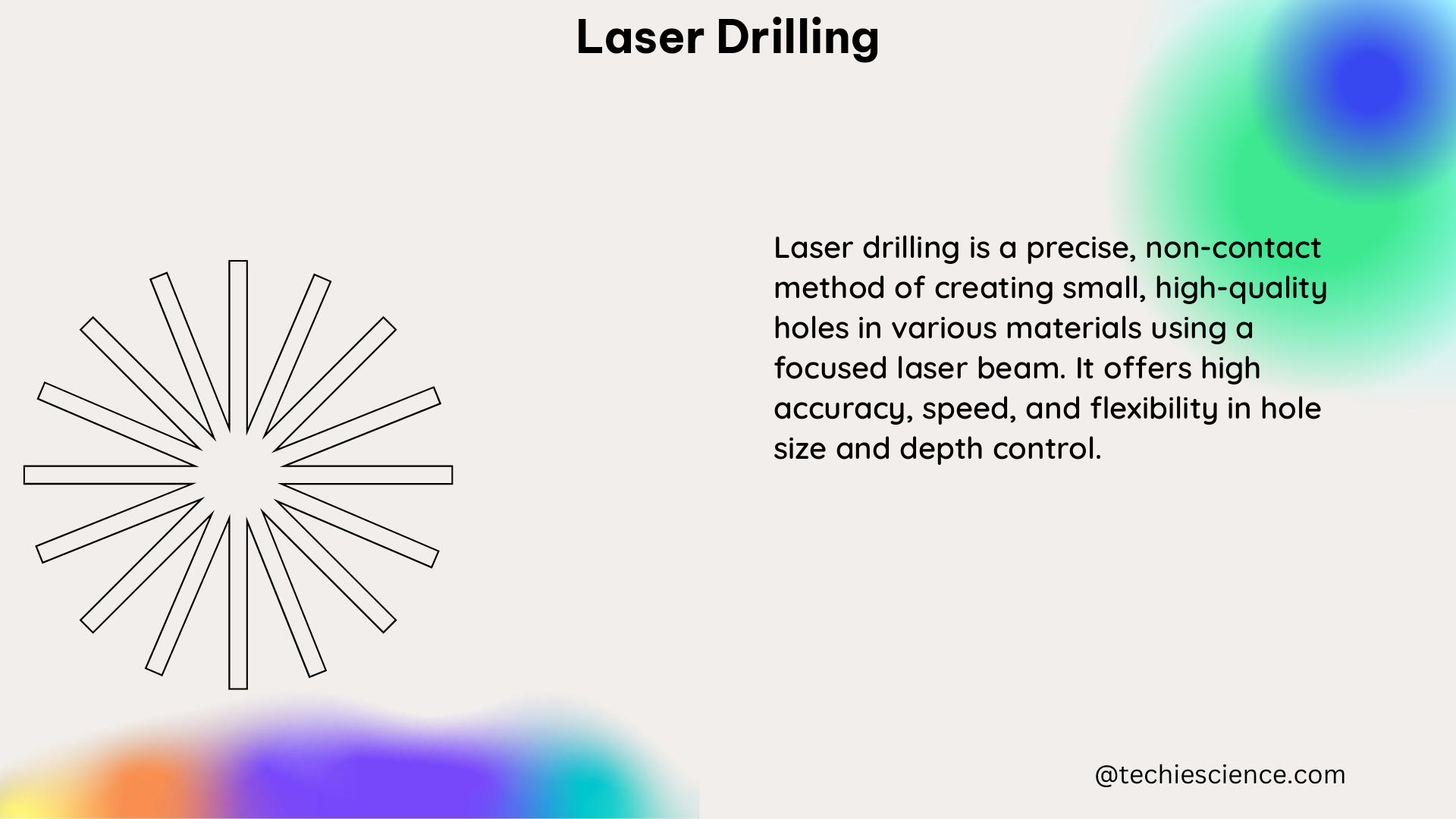Laser drilling is a highly precise and versatile manufacturing process that uses a laser beam to create holes in various materials. This process is characterized by its ability to produce high-quality holes with minimal heat-affected zones (HAZ) and excellent roundness. The quality of laser-drilled holes can be evaluated using several metrics, including roundness, Hillock ratio, taper, and HAZ.
Understanding the Fundamentals of Laser Drilling
Laser drilling is a non-contact, thermal-based material removal process that utilizes the high energy density of a focused laser beam to vaporize and eject material from the workpiece. The process involves the following key steps:
- Laser Beam Absorption: The laser beam is absorbed by the surface of the workpiece, causing localized heating and melting of the material.
- Material Removal: The intense heat generated by the laser beam causes the material to vaporize, creating a small hole or cavity in the workpiece.
- Ejection of Molten Material: The vaporized material is ejected from the hole, leaving behind a clean, high-quality opening.
The efficiency and quality of the laser drilling process are influenced by various parameters, including laser power, pulse duration, repetition rate, beam diameter, and the properties of the workpiece material.
Evaluating the Quality of Laser-Drilled Holes

The quality of laser-drilled holes can be assessed using several key metrics:
Roundness
The roundness of a laser-drilled hole is calculated as the average of the elliptical roundness at the entrance and exit sides of the hole. The elliptical roundness is calculated using the shorter or minor elliptical diameter and the longer or major elliptical diameter at the entrance or exit side of the hole. An average roundness of 1 indicates the best quality, with larger values indicating better drilling quality for an ideal circle.
The formula for calculating the elliptical roundness (ER) is:
ER = (Minor Diameter / Major Diameter) × 100%
Hillock Ratio
The Hillock ratio is a measure of the height of the hillock, or raised area, surrounding the hole relative to the diameter of the hole. A lower Hillock ratio indicates better drilling quality, with a value of 0 being the ideal.
The Hillock ratio (HR) is calculated as:
HR = Hillock Height / Hole Diameter
Taper
Taper is a measure of the change in diameter of the hole along its depth. A lower taper value indicates better drilling quality, with a value of 0 being the ideal.
The taper (T) is calculated as:
T = (Entrance Diameter – Exit Diameter) / Hole Depth
Heat-Affected Zone (HAZ)
The HAZ is the area around the hole that has been affected by the heat generated during the drilling process. A smaller HAZ indicates better drilling quality, with minimal distortion and damage to the material.
The size of the HAZ can be measured using various techniques, such as optical microscopy or scanning electron microscopy (SEM), and is typically reported in micrometers (μm).
Optimizing Laser Drilling Parameters
The quality of laser-drilled holes can be optimized by adjusting various control factors, such as laser pulse energy, repetition rate, focusing position offset, and drilling time. A study using a Quantel Brilliant Neodymium-doped Yttrium Aluminum Garnet (Nd: YAG) laser with a pulse width of 5-6 ns and F-theta lenses to deliver a focused laser beam with a diameter of 0.2 mm found the optimal combination of control factors to be A1B3C1D1, with a maximal variation of 0.406 obtained from the control factor B (focusing position offset), which had the greatest contribution to the drilling time.
Table 1: Optimal Combination of Control Factors for Laser Drilling
| Control Factor | Optimal Setting |
|---|---|
| A (Laser Pulse Energy) | A1 |
| B (Focusing Position Offset) | B3 |
| C (Repetition Rate) | C1 |
| D (Drilling Time) | D1 |
By understanding the relationships between these control factors and the resulting hole quality, laser drilling can be optimized to achieve the desired performance characteristics.
Advanced Techniques in Laser Drilling
Researchers have explored various advanced techniques to enhance the capabilities of laser drilling, including:
-
Dual-Beam Laser Drilling: This technique uses two laser beams, one for drilling and the other for assisting the drilling process. The assisting beam can help to reduce the HAZ and improve the quality of the drilled holes.
-
Underwater Laser Drilling: Performing laser drilling in a water-assisted environment can help to reduce the HAZ and improve the quality of the drilled holes by providing efficient cooling and debris removal.
-
Laser-Induced Plasma Assisted Drilling (LIPAD): LIPAD utilizes a laser-induced plasma to enhance the material removal rate and improve the quality of the drilled holes. The plasma can help to increase the absorption of the laser energy and facilitate the ejection of the molten material.
-
Femtosecond Laser Drilling: Femtosecond lasers, with pulse durations in the range of 10^-15 seconds, can produce high-quality, low-HAZ holes by minimizing the thermal effects on the workpiece material.
-
Hybrid Laser Drilling: Combining laser drilling with other techniques, such as mechanical drilling or electrical discharge machining, can help to improve the efficiency and quality of the drilling process.
These advanced techniques demonstrate the ongoing research and development in the field of laser drilling, aimed at addressing the challenges and expanding the capabilities of this versatile manufacturing process.
Applications of Laser Drilling
Laser drilling has a wide range of applications across various industries, including:
- Aerospace: Laser drilling is used for creating cooling holes in turbine blades, fuel injector nozzles, and other aerospace components.
- Electronics: Laser drilling is employed for creating vias (vertical interconnects) in printed circuit boards and microelectronic devices.
- Automotive: Laser drilling is used for creating fuel injection holes, cooling holes, and other precision features in automotive components.
- Medical: Laser drilling is utilized for creating micro-holes in medical devices, such as stents, catheters, and drug delivery systems.
- Jewelry and Watchmaking: Laser drilling is employed for creating intricate patterns and features in jewelry and watch components.
As the demand for high-precision, high-quality manufacturing continues to grow, the applications of laser drilling are expected to expand further, driving the need for continued research and development in this field.
Conclusion
Laser drilling is a highly precise and versatile manufacturing process that can produce high-quality holes with minimal heat-affected zones and excellent roundness. By understanding the fundamental principles, evaluating the quality metrics, and optimizing the control factors, laser drilling can be leveraged to address a wide range of industrial and technological challenges. The ongoing advancements in laser drilling techniques, such as dual-beam, underwater, and femtosecond laser drilling, further expand the capabilities of this innovative manufacturing process.
References
- Quantitative Analysis of Holes Produced in Laser Micromachining, https://asmedigitalcollection.asme.org/manufacturingscience/article-pdf/doi/10.1115/1.3123341/5934933/031011_1.pdf
- Multi-Objective Optimization of Nd: YAG Laser Drilling of Optical Components, https://www.ncbi.nlm.nih.gov/pmc/articles/PMC9785554/
- Review on laser drilling I. Fundamentals, modeling, and simulation, https://pubs.aip.org/lia/jla/article-abstract/25/1/012006/221181/Review-on-laser-drilling-I-Fundamentals-modeling?redirectedFrom=fulltext
- Laser Drilling of Metals: A Review, https://www.sciencedirect.com/science/article/abs/pii/S0924013613000749
- Laser Drilling: A Review, https://www.tandfonline.com/doi/abs/10.1080/10426914.2013.811637

Hi, I am Sanchari Chakraborty. I have done Master’s in Electronics.
I always like to explore new inventions in the field of Electronics.
I am an eager learner, currently invested in the field of Applied Optics and Photonics. I am also an active member of SPIE (International society for optics and photonics) and OSI(Optical Society of India). My articles are aimed at bringing quality science research topics to light in a simple yet informative way. Science has been evolving since time immemorial. So, I try my bit to tap into the evolution and present it to the readers.
Let’s connect through